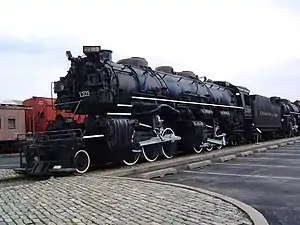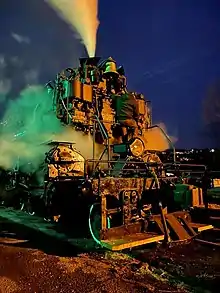Chesapeake and Ohio 1309
The Western Maryland Scenic Railroad No. 1309, formerly the Chesapeake and Ohio Railway No. 1309, is a compound articulated class "H-6" "Mallet" type steam locomotive with a 2-6-6-2 (Whyte notation) wheel arrangement. It was originally built by the Baldwin Locomotive Works in 1949 for the Chesapeake and Ohio Railway (C&O) where it pulled coal trains until retirement in 1956. It was the last steam engine built by Baldwin for the North American market. In 1976, it was moved to the B&O Railroad Museum for static display. The locomotive was later purchased in 2014 by the Western Maryland Scenic Railroad which began restoration to operating condition with the intention of returning it to service for tourist excursion service. The restoration was recently completed on December 31, 2020.
| Chesapeake & Ohio 1309 | |||||||||||||||||||||||||||||||||||||||||||||||||||||||||||||||||||||||||||
|---|---|---|---|---|---|---|---|---|---|---|---|---|---|---|---|---|---|---|---|---|---|---|---|---|---|---|---|---|---|---|---|---|---|---|---|---|---|---|---|---|---|---|---|---|---|---|---|---|---|---|---|---|---|---|---|---|---|---|---|---|---|---|---|---|---|---|---|---|---|---|---|---|---|---|---|
 C&O No. 1309 on static display at the B&O Railroad Museum in 2009 | |||||||||||||||||||||||||||||||||||||||||||||||||||||||||||||||||||||||||||
| |||||||||||||||||||||||||||||||||||||||||||||||||||||||||||||||||||||||||||
| |||||||||||||||||||||||||||||||||||||||||||||||||||||||||||||||||||||||||||
| |||||||||||||||||||||||||||||||||||||||||||||||||||||||||||||||||||||||||||
| |||||||||||||||||||||||||||||||||||||||||||||||||||||||||||||||||||||||||||
History
Chesapeake & Ohio Railway No. 1309 was built by Baldwin Locomotive Works in 1949. It was the last Class 1 mainline locomotive built by Baldwin, maker of over 70,000 locomotives since 1832. It was ordered by the Chesapeake and Ohio Railway to pull heavy coal trains in the mountainous terrain of West Virginia and Kentucky which it did from 1949 until 1956,[2][3] after which it was stored for twenty years at their roundhouse at Peach Creek, West Virginia.[3] The locomotive, along with several others, all considered impractical to restore to working condition, were moved to the B&O Railroad Museum in Baltimore, Maryland in 1976 for cosmetic restoration and static display.[4] It remained there until 2014 when it was purchased by the Western Maryland Scenic Railroad for restoration. When returned to service, it will be the largest steam locomotive in regular scheduled service in the United States and take 2-8-0 No. 734’s place as the largest active steam locomotive in the state of Maryland.[lower-alpha 1] The Western Maryland intends to use the locomotive on tourist excursion trains between Cumberland and Frostburg, Maryland.[5]
Description
No. 1309 was built from a 40-year-old design, with mechanical lubricators, stoker, and superheater, the last of a series of 2-6-6-2s that the C&O began in 1911. A very similar design, the USRA 2-6-6-2, was chosen by the United States Railroad Administration as one of its standard designs thirty years earlier during World War I.[1]
The engine is a Mallet articulated locomotive. This design was a compound locomotive where steam was expanded once in smaller rear cylinders and the exhaust captured and expanded a second time in larger lower-pressure front cylinders. While compound locomotives are more efficient than single-expansion machines, their extra complication led to very few United States railroads using them after the turn of the century.[6] The added length of two sets of cylinders required the engines to be articulated to enable operation on tight radius turns common in mountainous areas in West Virginia and Kentucky coal country, which added even more complication. It also had two cross compound air compressors mounted on the smokebox door to supply enough air for frequent heavy braking needed in mountain railroading. While complicated and uncommon, the C&O had a long history with Mallets and they were ideal for slow speed work in West Virginia.[1]
The Chesapeake and Ohio ordered 25 of these engines in 1948 to pull coal trains. When coal production dramatically fell due to labor unrest in 1949, the order was revised to just ten engines (numbered 1300 to 1309), and 1309 became the last domestic steam locomotive built by Baldwin.[7]
Restoration
The Western Maryland's restoration, which began in July 2014,[8] includes returning all parts to meet or exceed original specifications. The railroad claims the engine will be "better and more reliable than it was in 1949". The engine and tender were disassembled and then rebuilt with new parts where necessary. The engine's cab and floors were among the pieces replaced.[2]
In April 2016, Western Maryland Scenic Railroad No. 734, an ex-Lake Superior and Ishpeming 2-8-0 "Consolidation" type, was taken out of excursion service, as it was about due for a 1,472-day boiler inspection required by the Federal Railroad Administration.[9] Without a steam locomotive to operate or maintain, most of the railroad's money would be focused on 1309's proceeding restoration work.
In early January 2017, the railroad said the reassembly process at the shop in Ridgeley, West Virginia would begin that month and announced that the inaugural trip of the restored engine would be on July 1, 2017; it began selling tickets for the excursion.[8] That schedule was not met due to funding issues. The railroad had spent $800,000 but needed a matching grant of $400,000 from the state of Maryland to continue work.[10]
In August 2017, planned operation in November was further delayed until 2018 after corrosion was found on the locomotive's axles requiring additional work on the axles, wheel boxes, and crank pins.[11]
Restoration almost stopped in the fall of 2017 due to a lack of funding, although work on the wheels continued with donations.[11]
The railroad announced in November 2017 that restoration had stopped. $400,000 provided by the state of Maryland had been spent and the railroad estimated it would take at least $530,000 more to complete the restoration, including $120,000 for the running gear and $115,000 for the boiler. The railroad was soliciting donations from individuals, seeking additional grants, and raising money with "freight photo charters".[12]
In January 2018, Maryland state senator Wayne Norman proposed that Allegany County provide $530,000 to complete the restoration. The senator said there would be an economic benefit to the county in tourism, even drawing people from Europe and Asia. The county provides a $140,000 annual operating subsidy to the railroad, matched by $250,000 from the state of Maryland.[13]
In February 2018, the restoration project suffered another setback when the railroad learned that an employee had stolen parts, including bronze bearings and wear plates, and sold them for scrap at a salvage yard.[14] The thefts were discovered by the Allegany County Sheriff's Office after they were alerted by the scrap yard.[14] Stolen parts included 12 original crown brasses and 12 hub liners. The parts would have to be remade as they were damaged during removal.[15] The scrap yard had paid the employee a total of $14,662 for the parts,[16] some of which weighed 300 pounds (140 kg).[15] Formal charges have been filed against the employee.[15]

In June 2018, the boiler passed a hydrostatic test required by the Federal Railroad Administration. The boiler was pressurized to 25% above its maximum operation pressure of 210 pounds per square inch (1,400 kPa).[17] Stationary test firings to check for boiler leaks occurred several months later.[18] The restoration had cost $1.8 million as of mid-2018, including $800,000 provided by the state of Maryland.[17] The Western Maryland Scenic General Manager estimated the final cost will be $2.4 million.[19]
In September 2019, the project was again halted due to a lack of funds shortly after the front drivers were attached to the engine.[20] The railroad said it would no longer make estimates of when the restoration will be complete.[21] The total spent on the project was at $2.8 million.[22]
In February 2020, a new Crowdfunding campaign has been announced to try and raise the remaining $390,000 needed to finish the restoration. Once the money is raised, the organizers claim the restoration can be completed in six months.[22] In early May 2020, restoration work resumed. A successful fund raising effort promoted by Trains Magazine raised over $100,000.00 to get the work started again. The WMSR estimates they are still around $200,000.00 short of completing the work and developing a fund to cover initial operating expenses and facilities for fuel, water, and ash removal to name a few items.[23]
On December 31, 2020, the restoration has finally been completed and the locomotive moved under its own power for the first time in 64 years as part of a series of test runs to return it to operating condition.[24]
See also
Notes
- A much larger steam locomotive, the Union Pacific's Big Boy No. 4014 was restored to operational status in May 2019 but is being used for occasional excursion service as opposed to regularly scheduled service.
References
- C. B. Peck (ed.). 1950–52 Locomotive Cyclopedia of American Practice. New York: Simmons-Boardman. p. 518.
- Whetzel, Dan. "Classic #1309 American Mallet Vintage Steam Locomotive - Full Steam Ahead" (PDF). Mountain Discoveries (Spring 2017). Cumberland, Maryland. pp. 24–25. Retrieved January 4, 2019.
- "Chesapeake & Ohio 2-6-6-2 #1309". american-rails-com. Retrieved January 5, 2019.
- Kelly, Robert (August 18, 1976). "C&O 'Dead Dragons' Are Museum-Bound". Beckley Post-Herald. Beckley, West Virginia. p. 16. Retrieved January 6, 2019 – via newspapers.com.

- Haddock Taylor, Barbara (June 3, 2016). "Restoration of the 1309". The Baltimore Sun. Retrieved January 4, 2019.
- C.B. Peck (ed.). 1950–52 Locomotive Cyclopedia of American Practice. New York: Simmons-Boardman. pp. 500–538.
- James E. Casto (2006), The Chesapeake and Ohio Railway, Arcadia Publishing, pp. 58–, ISBN 978-0-7385-4334-5, retrieved January 5, 2019
- Gunnoe, Chase (January 11, 2017). "Western Maryland Scenic says July 1 will be 1309's debut". Trains. Retrieved January 5, 2019.
- "| FRA". dotcms.fra.dot.gov. Retrieved November 30, 2020.
- Gunnoe, Chase (April 26, 2017). "Western Maryland Scenic says funding delays will delay C&O 1309 restoration". Trains. Retrieved January 5, 2019.
- Edmonson, R G (August 2, 2017). "Western Maryland Scenic: 1309 project "is eating us out of house and home"". Trains. Retrieved January 5, 2019.
- Enoch, Hayley (November 17, 2017). "Railroad out of money for 2-6-6-2 restoration, stops work". Trains. Retrieved January 5, 2019.
- Edmonson, R G (January 29, 2018). "One Maryland state legislator calls on Allegany County to foot remaining bills for 2-6-6-6 No. 1309". Trains. Retrieved January 5, 2019.
- Wolford, Heather (February 14, 2018). "Former scenic railroad worker facing theft charges". Cumberland Times-News. Retrieved January 5, 2019.
- Edmonson, R G (February 23, 2018). "Contractor for 1309 says locomotive brasses part of metal stolen". Trains. Retrieved January 5, 2019.
- Edmonson, R G (February 23, 2018). "Formal charges made public in Maryland locomotive brass theft". Trains. Retrieved January 5, 2019.
- Wrinn, Jim (June 8, 2018). "Western Maryland Scenic restarts work on 1309 with successful FRA hydro". Trains. Retrieved January 5, 2019.
- Gunnoe, Chase (October 3, 2018). "Western Maryland Scenic test fires 2-6-6-6 No. 1309". Trains. Retrieved January 5, 2019.
- Wrinn, Jim (December 12, 2018). "20 questions for John Garner at Western Maryland Scenic Railroad about the restoration of 2-6-6-2 No. 1309". Trains. Retrieved January 5, 2019.
- Wrinn, Jim (August 24, 2019). "Western Maryland 1309 project halts again for need of funding". Trains Magazine. Retrieved November 2, 2019.
- Wrinn, Jim (June 25, 2019). "Western Maryland 1309 restoration update: Cranes on the horizon". Trains Magazine. Retrieved November 2, 2019.
- "It's time to fire up Baldwin's last steam locomotive - Trains Magazine - Trains News Wire, Railroad News, Railroad Industry News, Web Cams, and Forms". cs.trains.com. Retrieved February 5, 2020.
- "Work Resumes on Western Maryland Scenic #1309". Trains Magazine News Wire. May 13, 2020.
- Wrinn, Jim (December 31, 2020). "'Last Baldwin,' Western Maryland Scenic No. 1309, makes first move under own power". Trains.com Newswire. Kalmbach Media.